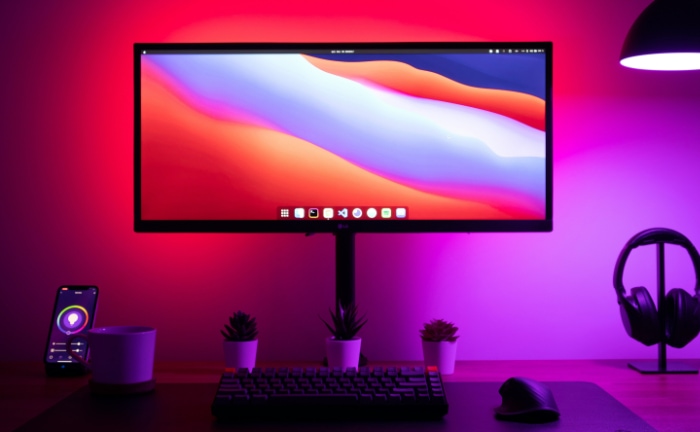How Do Smart Lights Work: Tech That Illuminates

Have you ever wondered how a simple voice command or a tap on your smartphone can control the ambiance of your room? Or how these advanced bulbs contribute to energy savings and enhanced home security? From setting the perfect mood for a movie night to waking up to a gentle, sunrise-like glow, smart lights are redefining our interaction with light.
The Basics of Smart Lighting
Smart lighting marks a significant leap from traditional lighting solutions. These innovative systems do more than illuminate spaces; they bring enhanced functionality and convenience into our homes.
What Defines Smart Lights
Smart lights are a step ahead of conventional bulbs. They connect to wireless networks, allowing users to control them remotely through smartphones, tablets, or voice-activated devices.
Unlike traditional bulbs, smart lights offer features like color change, dimming, and scheduling. The essence of smart lighting lies in its connectivity and the ability to integrate with other smart home devices, creating a seamless and intuitive home environment.
Essential Components of Smart Lights
At the heart of every smart light are key components that make it ‘smart’. These include:
- Wireless Connectivity Modules: Enabling the bulbs to connect to home networks.
- LED Technology: Most smart bulbs use LED technology, known for energy efficiency and longevity.
- Control Interfaces: These can range from mobile apps to voice control systems, allowing users to manage lighting settings remotely.
Comparison With Traditional Lighting
Traditional bulbs, like incandescent or CFLs, lack connectivity and smart features. They operate simply: turn on or off, with no option to control brightness or color.
Smart lights, on the other hand, offer a dynamic range of functionalities. They can be dimmed, have their color changed, and even be programmed to follow schedules, all of which are impossible with standard lighting options.
This flexibility not only enhances the ambiance of a space but also contributes to energy efficiency and cost savings.
Types of Smart Lights in the Market
The market for smart lights is diverse, catering to various needs and preferences. Here are some common types:
- Standard Smart Bulbs: These are the most basic form, offering remote control, dimming, and sometimes color-changing capabilities.
- Color-Changing Bulbs: These bulbs can display multiple colors, perfect for mood lighting or decorative purposes.
- Smart Light Strips: Flexible and versatile, these are used for accent lighting, under cabinets, or around entertainment systems.
- Smart Light Panels: For those who love artistic and modern designs, these panels can be arranged in various patterns on walls.
- Integrated Smart Lighting Fixtures: These include ceiling lights and outdoor lighting solutions that come with built-in smart technology.
Connectivity and Control Mechanisms
Smart lights are not just about the brightness or color they emit; their real power lies in how they connect and can be controlled.
Wireless Connectivity Options
The backbone of smart lighting is its ability to connect wirelessly. Here are the main technologies used:
- Bluetooth: Enables direct control of the light from a nearby device without needing an internet connection.
- Wi-Fi: Connects the lights to your home network, allowing control from anywhere with internet access.
- Zigbee and Z-Wave: These are low-power wireless technologies that require a hub or bridge to connect the lights to your home network.
Each of these technologies has its advantages and suits different needs, from simple setups with Bluetooth to more complex, whole-home systems using Zigbee or Z-Wave.
Role of a Smart Home Hub or Bridge
While some smart lights work directly with Wi-Fi or Bluetooth, others, especially those using Zigbee or Z-Wave, require a hub or bridge. This device acts as a translator, enabling communication between the lights and your home network.
The hub also allows for more complex automations and integrations with other smart home devices.
Controlling Smart Lights
The real convenience of smart lights comes from the various control options available:
- Mobile Apps: Most smart lighting systems come with a dedicated app. These apps allow you to turn lights on or off, adjust brightness, change colors, set schedules, and create scenes.
- Voice Commands: Integration with voice assistants like Amazon Alexa, Google Assistant, or Apple Siri lets you control lights using just your voice.
- Automation: Smart lights can be programmed to respond to various triggers, like turning on at sunset or changing color when you receive a phone call.
Features and Functionalities

Smart lights are far more than your average light bulbs. They come loaded with a range of features that not only provide convenience but also enhance the ambiance and energy efficiency of your home.
Adjusting Brightness and Color
One of the most appealing aspects of smart lights is the ability to adjust their brightness and color. This means you can dim the lights for a movie night or brighten them for reading, all from your phone or voice command.
Color-changing bulbs take this a step further, allowing you to set the mood with different colors, from warm yellows for a cozy atmosphere to cool blues for a calming effect.
Scheduling and Timers
Smart lights offer the functionality to set schedules and timers. This feature is perfect for those who want their lights to turn on and off at specific times – for instance, lights that automatically turn on at dusk and off at dawn.
This not only adds convenience but also enhances home security, as it can give the appearance that someone is home even when they’re not.
Scene Setting and Integration
Scene setting is another exciting feature of smart lights. You can create scenes for different activities – like a ‘dinner party’ scene with soft, warm lights or a ‘work’ scene with bright, focused lighting.
Integration with other smart home devices takes this further. Imagine your lights dimming as the movie starts on your smart TV, all happening seamlessly.
Energy Efficiency and Cost-Effectiveness
Smart lights, especially those using LED technology, are known for their energy efficiency. They consume less power compared to traditional bulbs, leading to cost savings on electricity bills.
Additionally, the ability to control and automate lights means they’re only on when needed, further reducing energy usage.
Installation and Setup
Transitioning to smart lighting is not just about purchasing the bulbs. The installation and setup process is crucial for ensuring that your smart lights work efficiently and as intended.
Step-by-Step Guide on Installing Smart Lights
Installing smart lights is generally straightforward and similar to replacing a standard bulb. Here’s a simple process to follow:
- Choose the Right Bulbs: Ensure the smart bulbs fit your existing fixtures in terms of size and socket type.
- Install the Bulb: Turn off the power to the light fixture, replace the old bulb with the smart bulb, and then turn the power back on.
- Connect to a Network: If the bulb uses Wi-Fi, connect it to your home network. For Zigbee or Z-Wave bulbs, ensure you have the necessary hub or bridge.
Configuring with Various Control Systems
Once the bulbs are installed and connected, the next step is to configure them with your preferred control system:
- Using a Mobile App: Download the app associated with your smart lights. Follow the app’s instructions to pair and configure your bulbs.
- Setting Up Voice Control: If you’re using a voice assistant like Alexa or Google Assistant, link your smart lighting system to the assistant through its app.
Tips for Optimizing Smart Light Placement and Usage
To get the most out of your smart lights, consider these tips:
- Strategic Placement: Think about where you need smart functionality the most. Common areas include living rooms, bedrooms, and entryways.
- Utilize Features: Take advantage of scheduling, dimming, and color-changing features to enhance your daily routines and save energy.
- Integration: For a comprehensive smart home experience, integrate your lights with other smart devices like thermostats, cameras, and sensors.
Conclusion
Smart lights represent a significant advancement in home technology, blending innovation with everyday functionality. Throughout this exploration, we’ve uncovered the intricate workings of these devices, from their basic components and types to the complex connectivity and control mechanisms that make them so versatile.
The features and functionalities of smart lights, like adjustable brightness, color settings, scheduling, and integration with other smart home devices, not only enhance home ambiance but also contribute to energy efficiency and convenience. Installation and setup, while straightforward, require careful consideration to fully harness the potential of smart lighting.
It’s clear that smart lights are more than just a technological novelty; they’re a practical addition to any modern home, offering both aesthetic and practical benefits. With their ability to transform and adapt to our needs, smart lights are undoubtedly a bright idea for those looking to bring a touch of the future into their living spaces.
As technology continues to evolve, we can expect even more innovative features and uses for smart lighting, further illuminating the path towards a more connected and efficient home.


